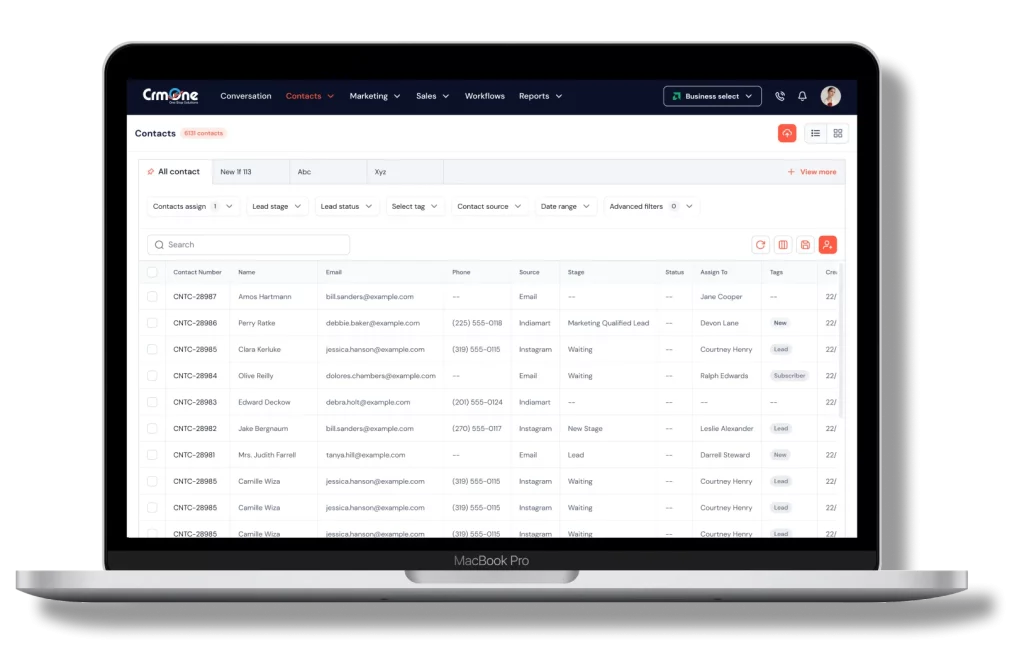what is Social media management? managing Social media encompasses the process of creating, scheduling, analyzing, and engaging with content posted on various social media platforms. It involves strategies to effectively reach and engage with the target audience while aligning with the brand’s goals and identity.
A social media manager plays a pivotal role in social media management by overseeing all aspects of a brand’s social media presence. They strategize and execute social media marketing campaigns, monitor social media networks, and analyze performance metrics to optimize content and engagement.
Social media management involves:
Creating Social Media Posts: Developing content that is engaging, informative, and visually appealing to attract social media users.
Social Media Marketing Management: Utilizing social media platforms as marketing channels to promote products, services, or content to a targeted audience.
Engaging with Social Media Followers: Interacting with followers through comments, messages, and shares to build relationships and enhance brand loyalty.
Developing a Social Media Marketing Strategy: Formulating comprehensive plans that outline goals, target audience, content calendars, and promotional tactics to achieve business objectives.
Implementing Social Media Management Strategy: Applying strategies to manage and optimize the brand’s social media presence effectively.
Effective social media management requires a deep understanding of social media platforms, trends, and audience behavior. It involves staying updated on algorithm changes, leveraging analytics tools to measure performance, and adapting strategies to ensure maximum engagement and impact.
Why is social media management important?

Social media management is crucial for businesses due to its ability to enhance brand visibility, engage with the target audience effectively, and drive business growth. Here’s why it’s important:
Enhanced Brand Visibility: Managing social CRM platforms allows businesses to reach a broader audience across various social media networks. This visibility increases brand awareness and attracts potential customers.
Targeted Audience Engagement: By understanding social media audience personas, businesses can tailor content and interactions to resonate with specific demographics. This targeted approach fosters deeper connections with the audience.
Effective Monitoring and Listening: Using social media management platforms enables businesses to manage social media monitoring and social media listening effectively. They can track mentions, comments, and trends in real-time, allowing for timely responses and proactive engagement.
Strategic Advertising Opportunities: Social media platforms offer paid social media ads that allow businesses to target specific demographics based on interests, behaviors, and demographics. This targeted advertising can drive traffic, leads, and sales.
Dedicated Management: Having a dedicated social media manager ensures consistent branding and messaging across platforms. They strategize, create content, engage with followers, and analyze performance metrics to optimize social media efforts.
Building Customer Loyalty: Regular interaction and engagement on social media help businesses build relationships with their audience. This engagement fosters trust and loyalty among loyal customers, leading to repeat business and positive word-of-mouth.
What are the key components of social media management?
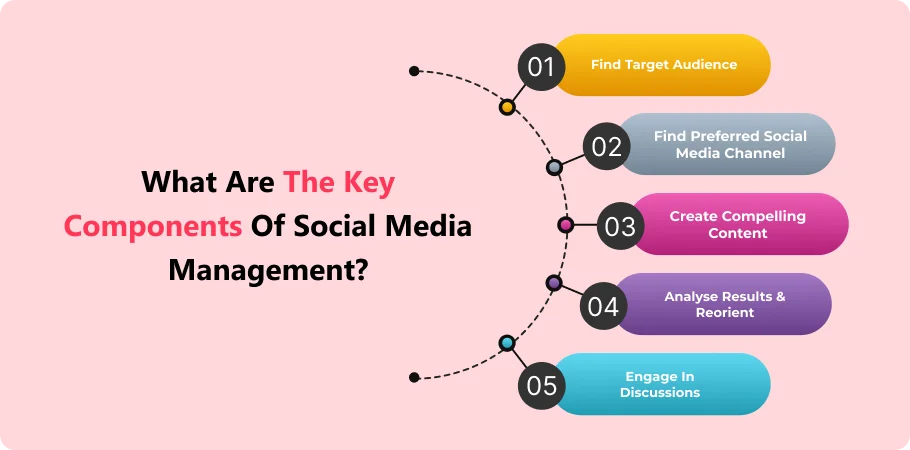
The key components of effective social media management encompass several crucial elements that collectively contribute to a successful online presence and engagement strategy:
Content Strategy and Creation: Developing a comprehensive social media strategy involves planning and creating engaging content tailored to various social platforms. This content aims to resonate with the target audience and reinforce brand identity.
Community Engagement: Actively managing social accounts includes responding to comments, messages, and interactions promptly. This engagement fosters relationships with followers and encourages increased brand awareness through organic interactions.
Social Media Monitoring and Listening: Utilizing social media listening tools enables businesses to track and analyze conversations, trends, and brand mentions across most social media platforms. This real-time monitoring helps in understanding audience sentiment and adapting strategies accordingly.
Advertising and Promotion: Leveraging social media advertising features allows businesses to target specific demographics with paid campaigns. This targeted approach enhances reach, drives traffic, and supports marketing objectives.
Analytics and Reporting: Regular social media reporting provides insights into social media performance metrics such as engagement rates, follower growth, and content effectiveness. These analytics inform strategy adjustments and optimize future campaigns.
Integration of Social Media Tools: Using social media tools streamlines management tasks, scheduling posts, analyzing data, and monitoring performance. These tools enhance efficiency and effectiveness in managing multiple social media channels.
Which social media platforms should businesses focus on?

When deciding which social media management platforms to focus on, businesses should conduct thorough research into their target audience’s demographics and online behavior. Understanding where their audience spends the most time allows businesses to choose platforms that will maximize their reach and engagement.
For instance, platforms like Instagram and TikTok are popular among younger demographics who engage more with visual content, whereas LinkedIn is better suited for professional networking and B2B marketing.
Each platform offers unique features and audience demographics, making it crucial for businesses to select the ones that align best with their industry and content type. By focusing efforts on the right platforms, businesses can tailor their content to resonate effectively with their audience and achieve their marketing objectives.
Moreover, leveraging tools such as Google Analytics helps in tracking performance across multiple platforms, enabling businesses to refine their strategies and optimize their efforts for targeted campaigns and raising brand awareness. This strategic approach ensures that businesses not only reach their desired audience but also build a strong online presence that supports their overall marketing goals.
How do different social media platforms vary in terms of audience and content?

Each social media platform has distinct characteristics that cater to specific audience preferences and content styles.
Instagram, known for its visual-centric nature, thrives on high-quality images and engaging videos. This platform is ideal for businesses that can showcase products, services, and brand stories through visually appealing content. The emphasis on aesthetics and storytelling makes Instagram suitable for building a visually compelling brand identity and fostering consumer engagement through creative visuals.
Twitter, on the other hand, is characterized by its concise, text-heavy format. It is best suited for quick updates, news announcements, and engaging in real-time conversations. Businesses can leverage Twitter to share industry insights, participate in trending topics, and directly interact with their audience through tweets and hashtags. Its fast-paced nature encourages immediate engagement and facilitates virality through retweets and replies.
LinkedIn stands out as a professional networking platform, making it ideal for B2B marketing and professional content. Businesses can share thought leadership articles, industry news, and job postings to establish authority within their industry. LinkedIn’s audience values professionalism and expertise, making it a valuable platform for building professional networks, generating leads, and nurturing business relationships.
TikTok has rapidly gained popularity among younger audiences for its short-form, entertaining video content. Businesses can create engaging and creative videos that resonate with a younger demographic, showcasing product demonstrations, behind-the-scenes content, or participating in viral challenges. TikTok’s algorithm-driven discovery features can help businesses reach a broader audience and increase brand visibility through engaging and shareable content.
What do social media managers do?
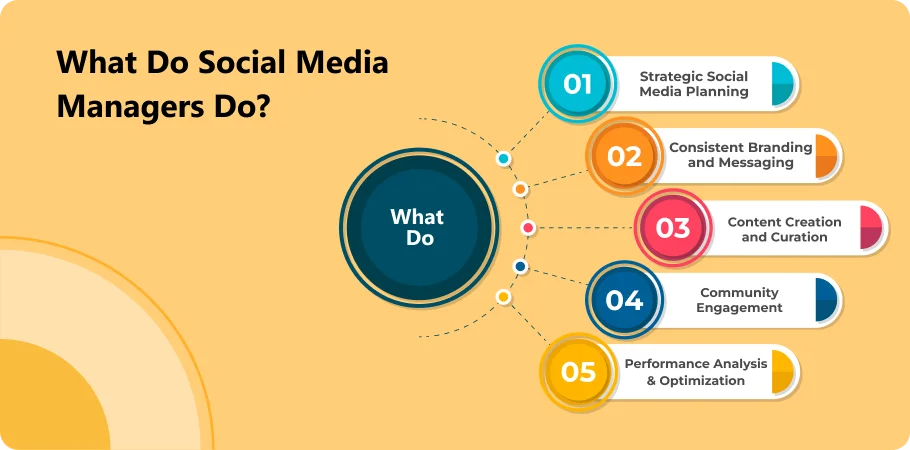
Social media managers oversee content creation and management, engage with followers, analyze performance metrics, and develop social media strategies. They play a crucial role in maintaining a consistent brand voice and achieving social media objectives.
A social media manager ensures that content aligns with the brand’s identity and resonates with the target audience. They stay updated on trends and algorithm changes to optimize performance. Social media manager’s are responsible for crafting posts and campaigns that engage and grow the audience.
Key responsibilities of social media manager’s include:
- Content Creation and Management: Developing visually appealing and relevant content that fits the brand’s image.
- Engaging with Followers: Interacting with followers through comments, messages, and mentions to build relationships and foster loyalty.
- Analyzing Performance Metrics: Monitoring engagement rates, follower growth, and conversion rates to refine strategies.
- Developing Social Media Strategies: Creating comprehensive plans to guide the brand’s social media activities.
- Ensuring Consistency in Brand Voice: Upholding a consistent and trustworthy brand identity across all social media platforms.
Why might businesses need many social media managers?

Larger businesses with extensive social media presence often require a structured approach to manage their online platforms effectively. This includes dividing responsibilities among multiple social media managers, each specializing in various aspects such as content creation, community management, analytics, and paid advertising.
Content Creation:
One social media manager may focus on developing and curating content that aligns with the brand’s voice and resonates with the target audience. They ensure that the content is engaging, relevant, and consistent across different social media channels.
Community Management:
Another manager might be dedicated to engaging with the audience by responding to comments, messages, and mentions promptly. They foster relationships, address customer inquiries, and manage online communities to enhance brand loyalty and reputation.
Analytics:
A social media manager specializing in analytics uses tools like Google Analytics and social media insights to track key performance metrics. They analyze data such as engagement rates, reach, and conversion rates to assess the effectiveness of campaigns and strategies.
Paid Advertising:
Managing paid advertising campaigns requires expertise in targeting, budget management, and ad optimization. A dedicated social media manager focuses on creating and monitoring paid campaigns across various platforms to maximize ROI and reach specific business goals.
Book a CrmOne Demo
Experience the CrmOne simplicity and power. Our experts will show you the best ways to use it and answer your questions in real time. See how CRMOne fits your needs.
What is a social media strategy?
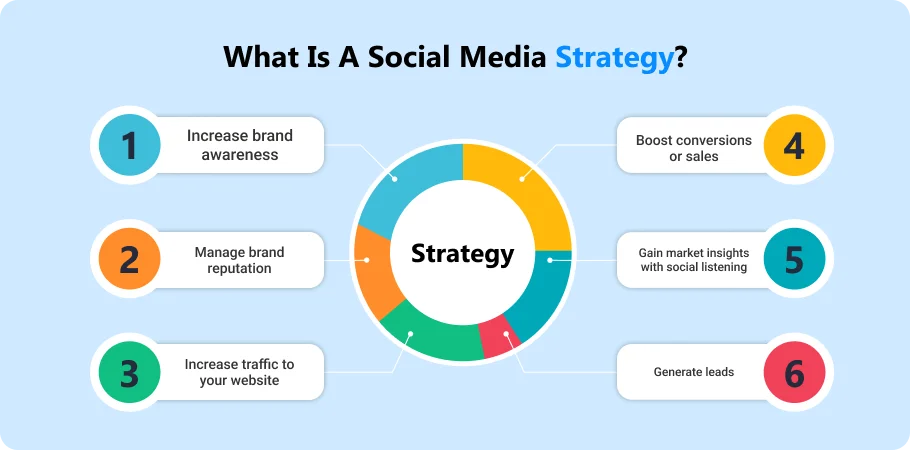
Social media management strategy is a detailed blueprint that outlines how a business intends to utilize various social media platforms to achieve its marketing and communication goals effectively. It begins with setting clear objectives that are specific, measurable, achievable, relevant, and time-bound (SMART). These goals serve as the foundation for all subsequent activities on social media.
Identifying the target audience is another critical aspect of the strategy. This involves understanding the demographics, interests, and behaviors of the audience to tailor content that resonates with them. By knowing where their audience spends most of their time online, businesses can strategically choose the right platforms. For example, platforms like Instagram and TikTok may be ideal for reaching younger demographics interested in visual content, while LinkedIn might be more suitable for professional networking and B2B interactions.
Creating compelling content is essential to engage and captivate the audience. This includes developing posts, videos, and other media that align with the brand’s identity and cater to the preferences of each platform’s users. Implementing engagement tactics such as responding to comments, initiating discussions, and sharing user-generated content helps in fostering meaningful interactions and building a community around the brand.
Measuring performance through key metrics such as reach, engagement rates, conversion rates, and sentiment analysis is crucial for evaluating the effectiveness of the strategy. Tools like social media analytics and Google Analytics provide valuable insights into what content resonates best with the audience and which strategies need adjustment.
What is social media content creation?

Social media content creation involves generating engaging and relevant content for many social media platforms. This includes images, videos, infographics, articles, and more. The goal is to attract, engage, and retain your target audience.
Effective audience research guides the process by understanding demographics, preferences, and behaviors. Choosing the right social media platforms ensures content reaches the appropriate audience. Utilizing social media tools streamlines management and enhances performance tracking. Regular social media reports and social media listening refine strategies based on audience interaction and feedback.
How to create compelling social media content?
- To create compelling social media content:
- Know your audience.
- Use high-quality visuals.
- Write engaging captions.
- Incorporate trending hashtags.
- Post consistently.
- Use storytelling.
- Include a call to action.
What is a social media calendar?

A social media calendar is an essential planning tool that enables businesses to schedule their social media posts systematically and effectively. It helps maintain a consistent posting schedule and allows for strategic content planning around key dates and events.
Using a social media calendar, businesses can manage their social media activities by scheduling posts in advance. This ensures a steady flow of content aligned with their marketing objectives, keeping their audience engaged regularly.
Additionally, social media management tools are integral to the management of social media calendars. These tools facilitate efficient content scheduling, performance tracking, and analysis through social media reports. By leveraging these insights, businesses can optimize their strategies based on engagement metrics and audience behavior.
In summary, a well-structured social media calendar supported by social media tools not only aids in organizing content but also enhances the overall management of social media activities, enabling businesses to maintain consistency and effectiveness in their online presence.
How to create a social media content calendar?
- To create a social media content calendar:
- Choose a template or tool.
- Mark important dates.
- Plan content themes.
- Schedule posts in advance.
- Review and adjust regularly.
What is social media monitoring?

By actively monitoring social media channels, businesses can manage social media listening effectively to stay informed about customer feedback, industry trends, and potential issues. This proactive approach allows for timely responses to both positive and negative mentions, fostering better customer relationships and brand reputation management.
Additionally, social media monitoring involves generating social media reports that summarize key metrics such as engagement levels, sentiment analysis, and reach. These reports help businesses assess the impact of their social media efforts and adjust strategies as needed to achieve their marketing goals.
Social media monitoring supported by social media listening and social media report enables businesses to proactively engage with their audience, mitigate risks, and optimize their manage social media activities for enhanced brand visibility and customer satisfaction.
How to increase brand awareness on social media?
- To increase brand awareness on social media:
- Post consistently.
- Use high-quality visuals.
- Engage with your audience.
- Collaborate with influencers.
- Run social media ads.
- Utilize user-generated content.
What are social media ads?

Social media ads are powerful tools utilized by businesses to amplify their reach and engagement on social media platforms through paid promotions. These advertisements are strategically crafted to target specific demographics, interests, and behaviors of users, maximizing their effectiveness in reaching the intended audience.
In terms of objectives, social media ads can be tailored to achieve specific goals such as increasing brand awareness, driving website traffic, generating leads, or boosting sales. Advanced analytics and reporting tools provided by social media platforms enable businesses to track the performance of their ads in real-time, allowing for timely optimizations and adjustments to maximize return on investment (ROI).
How will AI impact social media management?
AI is set to revolutionize best social media management by introducing automation and advanced analytics capabilities that enhance efficiency and effectiveness across various tasks. One significant impact of AI in social media management is the automation of repetitive tasks.
Furthermore, AI facilitates personalized content creation by leveraging data analytics to understand individual preferences and behaviors. This enables businesses to tailor content specifically to each user’s interests, increasing relevance and engagement. Personalization also fosters stronger customer relationships and boosts brand loyalty.
What are the key takeaways for effective social media management?
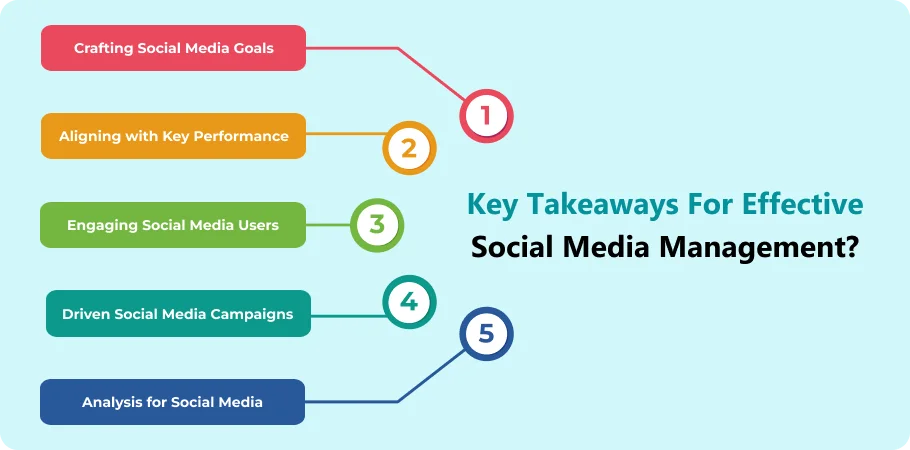
Effective social media management encompasses several key strategies that are essential for businesses to boost brand engagement and achieve marketing success. Here’s an elaboration on each key takeaway:
Understanding Your Target Audience:
Successful social media management begins with thorough audience research. This involves identifying demographics, interests, behaviors, and pain points of your target audience. By understanding who your audience is and what they care about, you can tailor your content and messaging to resonate with them effectively.
Creating Engaging Content:
Content is at the heart of social media engagement. Businesses need to create content that is not only relevant to their audience but also compelling and valuable. This includes a mix of posts, videos, images, infographics, and articles that capture attention, provoke interaction, and provide solutions or entertainment.
Conclusion
Effective social media management is crucial for businesses aiming to enhance brand visibility, engage with their audience, and drive growth in 2025. By implementing a strategic approach that includes creating compelling content, leveraging social media tools like CrmOne, and monitoring performance metrics, businesses can optimize their social media presence.
This involves understanding what is social media management and audience preferences, crafting targeted campaigns, and utilizing analytics to refine strategies continuously. Embracing upcoming trends such as AI integration and social commerce will further elevate brand engagement and ensure relevance in an ever-evolving digital landscape. With the right tools and strategies in place, businesses can effectively navigate social media platforms to achieve their marketing objectives and foster meaningful connections with their audience.
Get started for Free
Start for free today. Boost your sales by clicking the Get Started button. With CRMOne, you can manage leads, sales, and customer service all in one place.


